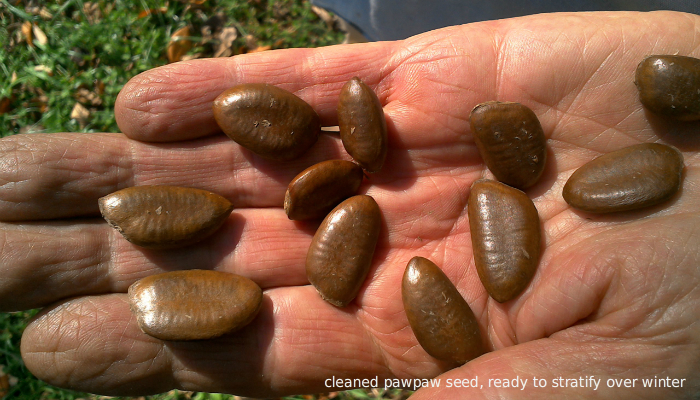Looking to Save Pawpaw Seed?

By Lon Drake
Last fall and earlier this year, I shared information with you about my pawpaw tree projects, which I’m interested in because of the loss of this native that used to inhabit the southern three to four county tiers in the state, and are critical to the zebra swallowtail butterfly. Establishing and maintaining pawpaw is only part of the story, as I’ve also shared with you thoughts on utilizing the fruit as well. And what I’ve found is that to begin fruit production, the trees usually need to be at least eight years old. If you have access to the fruit, this is the time to start harvesting the seeds to grow more trees. I now have more than a hundred young trees I’ve grown from seed and I’m happy to share a few tips on saving pawpaw seed that work well for me.
First: For this species, dry seed is dead seed, so the most important tip is to never let the seeds dry out.
Second: Remove the edible flesh because it contains growth inhibitors. Like many other fruits, the edible flesh contains these inhibitors, which prevent the seed from germinating while still on the tree. And the tree depends on animals to clean the seed. If not cleaned soon after ripening, the inhibitors will gradually damage, then kill, the embryo. If you are only processing a few seeds, just scrub them with a brush to remove all pulp, which will otherwise cause mold to grow during their overwinter stratification. For large quantities of seed, I rub the pulp through a quarter-inch mesh hardware cloth screen while blasting it with the garden hose. Rubbing the seed firmly against the screen by hand will not harm the seed.
Third: Winter stratification. The seeds need winter stratification for best germination results, and I keep them slightly moist while at refrigeration temperature. The tricky part about the stratification is not letting seed get moldy. My best method for pawpaw, so far, is to make a little bed of damp long-fiber sphagnum moss and suspend the seeds an inch or two above this moss bed on a screen in a damp environment. The moss can be rewetted as necessary and the seeds remain in very moist air without touching the wet moss.
Now is the time to start finding your own best pawpaw winter stratification arrangements, and I hope you will share any tips and success stories you have. Stay tuned in early spring for planting methods and tips after winter germination!


